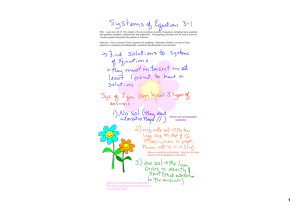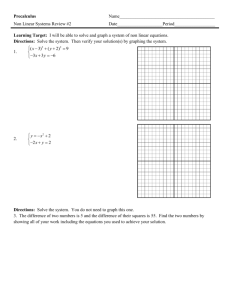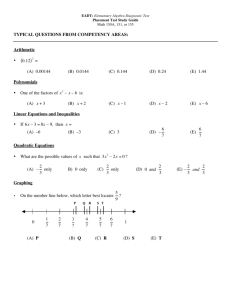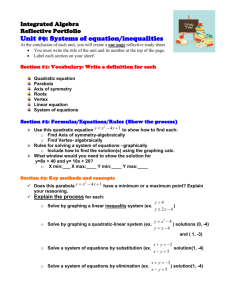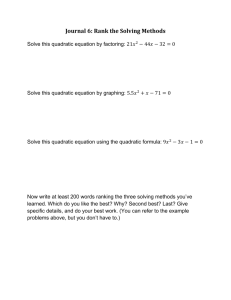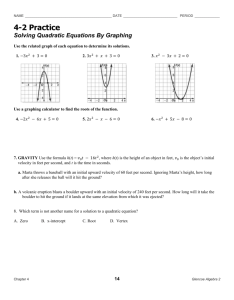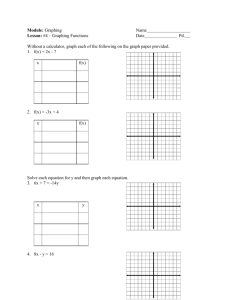Lesson 8-5
advertisement
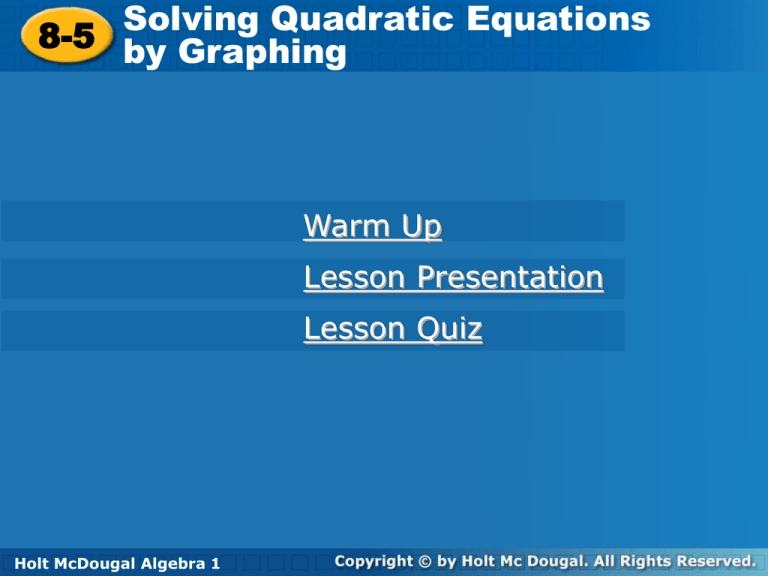
Solving Quadratic Equations Solving Quadratic Equations 8-5 8-5 byby Graphing Graphing Warm Up Lesson Presentation Lesson Quiz Holt Holt McDougal Algebra 1Algebra Algebra11 Holt McDougal Solving Quadratic Equations 8-5 by Graphing Warm Up 1. Graph y = x2 + 4x + 3. 2. Identify the vertex and zeros of the function in #1. vertex:(–2 , –1); zeros:–3, –1 Holt McDougal Algebra 1 Solving Quadratic Equations 8-5 by Graphing Objective Solve quadratic equations by graphing. Holt McDougal Algebra 1 Solving Quadratic Equations 8-5 by Graphing Vocabulary quadratic equation Holt McDougal Algebra 1 Solving Quadratic Equations 8-5 by Graphing Every quadratic function has a related quadratic equation. A quadratic equation is an equation that can be written in the standard form ax2 + bx + c = 0, where a, b, and c are real numbers and a ≠ 0. When writing a quadratic function as its related quadratic equation, you replace y with 0. So y = 0. y = ax2 + bx + c 0 = ax2 + bx + c ax2 + bx + c = 0 Holt McDougal Algebra 1 Solving Quadratic Equations 8-5 by Graphing One way to solve a quadratic equation in standard form is to graph the related function and find the x-values where y = 0. In other words, find the zeros of the related function. Recall that a quadratic function may have two, one, or no zeros. Holt McDougal Algebra 1 Solving Quadratic Equations 8-5 by Graphing Example 1A: Solving Quadratic Equations by Graphing Solve the equation by graphing the related function. 2x2 – 18 = 0 Step 1 Write the related function. 2x2 – 18 = y, or y = 2x2 + 0x – 18 Step 2 Graph the function. x=0 • The axis of symmetry is x = 0. • The vertex is (0, –18). • Two other points (2, –10) and (3, 0) • Graph the points and reflect them across the axis of symmetry. Holt McDougal Algebra 1 ● ● (3, 0) ● ● (2, –10) ● (0, –18) Solving Quadratic Equations 8-5 by Graphing Example 1A Continued Solve the equation by graphing the related function. 2x2 – 18 = 0 Step 3 Find the zeros. The zeros appear to be 3 and –3. Check 2x2 – 18 = 0 2(3)2 – 18 2(9) – 18 18 – 18 0 Holt McDougal Algebra 1 2x2 – 18 = 0 0 2(–3)2 – 18 0 0 Substitute 3 and –3 2(9) – 18 0 0 for x in the quadratic 18 – 18 0 0 equation. Solving Quadratic Equations 8-5 by Graphing Example 1B: Solving Quadratic Equations by Graphing Solve the equation by graphing the related function. –12x + 18 = –2x2 Step 1 Write the related function. y = –2x2 + 12x – 18 x=3 Step 2 Graph the function. • The axis of symmetry is x = 3. • The vertex is (3, 0). • Two other points (5, –8) and (4, –2). • Graph the points and reflect them across the axis of symmetry. Holt McDougal Algebra 1 ● ● ● ● (3, 0) ● (4, –2) ● (5, –8) Solving Quadratic Equations 8-5 by Graphing Example 1B Continued Solve the equation by graphing the related function. –12x + 18 = –2x2 Step 3 Find the zeros. The only zero appears to be 3. Check y = –2x2 + 12x – 18 0 –2(3)2 + 12(3) – 18 0 –18 + 36 – 18 0 0 Holt McDougal Algebra 1 Solving Quadratic Equations 8-5 by Graphing Example 1C: Solving Quadratic Equations by Graphing Solve the equation by graphing the related function. 2x2 + 4x = –3 Step 1 Write the related function. 2x2 + 4x + 3 = 0 y = 2x2 + 4x + 3 Step 2 Graph the function. Use a graphing calculator. Step 3 Find the zeros. The function appears to have no zeros. Holt McDougal Algebra 1 Solving Quadratic Equations 8-5 by Graphing Example 1C: Solving Quadratic Equations by Graphing Solve the equation by graphing the related function. 2x2 + 4x = –3 The equation has no real-number solutions. Check reasonableness Use the table function. There are no zeros in the Y1 column. Also, the signs of the values in this column do not change. The function appears to have no zeros. Holt McDougal Algebra 1 Solving Quadratic Equations 8-5 by Graphing Check It Out! Example 1a Solve the equation by graphing the related function. x2 – 8x – 16 = 2x2 Step 1 Write the related function. y = x2 + 8x + 16 Step 2 Graph the function. • The axis of symmetry is x = –4. • The vertex is (–4, 0). • The y-intercept is 16. • Two other points are (–3, 1) and (–2, 4). • Graph the points and reflect them across the axis of symmetry. Holt McDougal Algebra 1 x = –4 ●(–2 , 4) ● ● ● ● (–3, 1) (–4, 0) Solving Quadratic Equations 8-5 by Graphing Check It Out! Example 1a Continued Solve the equation by graphing the related function. x2 – 8x – 16 = 2x2 Step 3 Find the zeros. The only zero appears to be –4. Check y = x2 + 8x + 16 0 0 0 Holt McDougal Algebra 1 (–4)2 + 8(–4) + 16 16 – 32 + 16 0 Solving Quadratic Equations 8-5 by Graphing Check It Out! Example 1b Solve the equation by graphing the related function. 6x + 10 = –x2 Step 1 Write the related function. y = x2 + 6x + 10 Step 2 Graph the function. • The axis of symmetry is x = –3 . • The vertex is (–3 , 1). • The y-intercept is 10. • Two other points (–1, 5) and (–2, 2) • Graph the points and reflect them across the axis of symmetry. Holt McDougal Algebra 1 x = –3 ● (–1, 5) ● ● ● ● (–2, 2) (–3, 1) Solving Quadratic Equations 8-5 by Graphing Check It Out! Example 1b Continued Solve the equation by graphing the related function. 6x + 10 = –x2 Step 3 Find the zeros. There appear to be no zeros. You can confirm the solution by using the Table function. Enter the function and press There are no negative terms in the Y1 column. Holt McDougal Algebra 1 Solving Quadratic Equations 8-5 by Graphing Check It Out! Example 1c Solve the equation by graphing the related function. –x2 + 4 = 0 Step 1 Write the related function. y = –x2 + 4 Step 2 Graph the function. Use a graphing calculator. Step 3 Find the zeros. The function appears to have zeros at (2, 0) and (–2, 0). Holt McDougal Algebra 1 Solving Quadratic Equations 8-5 by Graphing Check It Out! Example 1c Continued Solve the equation by graphing the related function. –x2 + 4 = 0 The equation has two real-number solutions. Check reasonableness Use the table function. There are two zeros in the Y1 column. The function appears to have zeros at –2 and 2. Holt McDougal Algebra 1 Solving Quadratic Equations 8-5 by Graphing Example 2: Application A frog jumps straight up from the ground. The quadratic function f(t) = –16t2 + 12t models the frog’s height above the ground after t seconds. About how long is the frog in the air? When the frog leaves the ground, its height is 0, and when the frog lands, its height is 0. So solve 0 = –16t2 + 12t to find the times when the frog leaves the ground and lands. Step 1 Write the related function 0 = –16t2 + 12t y = –16t2 + 12t Holt McDougal Algebra 1 Solving Quadratic Equations 8-5 by Graphing Example 2 Continued Step 2 Graph the function. Use a graphing calculator. Step 3 Use to estimate the zeros. The zeros appear to be 0 and 0.75. The frog leaves the ground at 0 seconds and lands at 0.75 seconds. The frog is off the ground for about 0.75 seconds. Holt McDougal Algebra 1 Solving Quadratic Equations 8-5 by Graphing Check It Out! Example 2 What if…? A dolphin jumps out of the water. The quadratic function y = –16x2 + 32 x models the dolphin’s height above the water after x seconds. How long is the dolphin out of the water? When the dolphin leaves the water, its height is 0, and when the dolphin reenters the water, its height is 0. So solve 0 = –16x2 + 32x to find the times when the dolphin leaves and reenters the water. Step 1 Write the related function 0 = –16x2 + 32x y = –16x2 + 32x Holt McDougal Algebra 1 Solving Quadratic Equations 8-5 by Graphing Check It Out! Example 2 Continued Step 2 Graph the function. Use a graphing calculator. Step 3 Use to estimate the zeros. The zeros appear to be 0 and 2. The dolphin leaves the water at 0 seconds and reenters at 2 seconds. The dolphin is out of the water for 2 seconds. Holt McDougal Algebra 1 Solving Quadratic Equations 8-5 by Graphing Lesson Quiz Solve each equation by graphing the related function. 1. 3x2 – 12 = 0 2, –2 2. x2 + 2x = 8 –4, 2 3. 3x – 5 = x2 no solution 4. 3x2 + 3 = 6x 1 5. A rocket is shot straight up from the ground. The quadratic function f(t) = –16t2 + 96t models the rocket’s height above the ground after t seconds. How long does it take for the rocket to return to the ground? 6 s Holt McDougal Algebra 1
